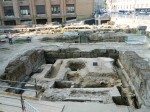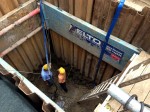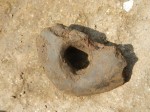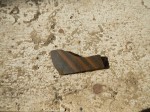 A team of archaeologists excavating the site of Sant’Omobono in the historic center of Rome have unearthed the foundations of one of the oldest temples in Rome. In the shadow of the 15th century church of Sant’Omobono just east of the Tiberine Island, archaeologists and students from the University of Michigan, the University of Calabria, the Museum of London Archaeology and the City of Rome dug a trench 15 feet deep to reveal the remains of an archaic temple from the 6th century B.C. when Rome was still ruled by Etruscan kings. Along with the remains of the first temple of Jupiter Capitolinus, also built under the reign of the kings in the 6th century B.C. and destroyed in 83 B.C. during Sulla’s second civil war, these are the oldest temple ruins found in Rome.
A team of archaeologists excavating the site of Sant’Omobono in the historic center of Rome have unearthed the foundations of one of the oldest temples in Rome. In the shadow of the 15th century church of Sant’Omobono just east of the Tiberine Island, archaeologists and students from the University of Michigan, the University of Calabria, the Museum of London Archaeology and the City of Rome dug a trench 15 feet deep to reveal the remains of an archaic temple from the 6th century B.C. when Rome was still ruled by Etruscan kings. Along with the remains of the first temple of Jupiter Capitolinus, also built under the reign of the kings in the 6th century B.C. and destroyed in 83 B.C. during Sulla’s second civil war, these are the oldest temple ruins found in Rome.
 Because the depth of the trench was seven and a half feet below the water table, the walls had to be shored up with metal sheeting and multiple sump pumps to allow the team to dig through the ancient layers. That’s why Alison Telfer, the Museum of London Archaeology expert, joined the team this season, because of her expertise in excavating waterlogged environments thanks to years of digging in soggy London.
Because the depth of the trench was seven and a half feet below the water table, the walls had to be shored up with metal sheeting and multiple sump pumps to allow the team to dig through the ancient layers. That’s why Alison Telfer, the Museum of London Archaeology expert, joined the team this season, because of her expertise in excavating waterlogged environments thanks to years of digging in soggy London.
After weeks of excavation, the team found three levels of masonry and a step. The stonework is exceptional, dry wall construction of precision-cut volcanic tufa blocks that are still beautifully flush even after millennia.
Terrenato says the archaeologists had to fight claustrophobia to be able to spend as much as 8 hours a day at the bottom of that trench.
“You’re in a very deep hole, and although you know in theory that the sheeting is going to hold everything up, there is a primal part of your brain that tells you to get out of there, if the walls come closing in there’s not going to be any way out for you,” he says.
The foundations of the temple of Fortuna were visible for only three days — for security reasons, the team could not leave the trench open and it had to be filled up again.
 To the west of the temple remains was discovered a large bank of clay that is so straight is can’t have been formed by human hands. Archaeologists believe it may have been built up against a vertical structure that is now gone, perhaps a wooden form that was removed or wall that has long since decayed. It could have been a river wall to protect the temple from flooding or perhaps used during the construction of the temple. About halfway down the clay bank, the team unearthed a group of vessels that are thought to have been votive offerings, sacrifices to the gods that were placed on the site when the bank was being built.
To the west of the temple remains was discovered a large bank of clay that is so straight is can’t have been formed by human hands. Archaeologists believe it may have been built up against a vertical structure that is now gone, perhaps a wooden form that was removed or wall that has long since decayed. It could have been a river wall to protect the temple from flooding or perhaps used during the construction of the temple. About halfway down the clay bank, the team unearthed a group of vessels that are thought to have been votive offerings, sacrifices to the gods that were placed on the site when the bank was being built.
The area in which the temple remains were discovered was known as the Forum Boarium, meaning “cattle market,” a center of trade on a bend in the river that was both a natural harbour and a crossing point of the Tiber. When the temple was built, Rome was already trading with the likes of Cyprus, Lebanon and Egypt as well as Italian peoples including the Latins, Etruscans and Sabines. The temple was deliberately built on the harbour so that it would welcome visitors and merchants, standing as a symbol of good will and fair trade guaranteed by the deity.
 Archaeologists believe the temple was dedicated to the goddess Fortuna. It was dismantled in the early Republican period, around the 5th century B.C., and replaced with twin temples dedicated to Fortuna and Mater Matuta, a Latin mother goddess whose temples have been found on other ports. The temples were added to and rebuilt over the centuries through at least the second century A.D. In the sixth century an early Christian church was built on the site. The podium of the twin temples, made out of tufa slabs, still survives. It is now part of the foundation of the church of Sant’Omobono.
Archaeologists believe the temple was dedicated to the goddess Fortuna. It was dismantled in the early Republican period, around the 5th century B.C., and replaced with twin temples dedicated to Fortuna and Mater Matuta, a Latin mother goddess whose temples have been found on other ports. The temples were added to and rebuilt over the centuries through at least the second century A.D. In the sixth century an early Christian church was built on the site. The podium of the twin temples, made out of tufa slabs, still survives. It is now part of the foundation of the church of Sant’Omobono.
 And that’s not all this archaeological site has to offer. Since it was first discovered during the burst of Fascist construction in the city center in the 1930s, the Sant’Omobono area has revealed evidence from 17 different phases of human occupation, from pottery sherds that date to between the 16th and the 12th centuries B.C., some of the earliest artifacts ever found indicating human habitation of the spot that would become Rome, to the remains of wattle and daub structures from the seventh century B.C.
And that’s not all this archaeological site has to offer. Since it was first discovered during the burst of Fascist construction in the city center in the 1930s, the Sant’Omobono area has revealed evidence from 17 different phases of human occupation, from pottery sherds that date to between the 16th and the 12th centuries B.C., some of the earliest artifacts ever found indicating human habitation of the spot that would become Rome, to the remains of wattle and daub structures from the seventh century B.C.
To read Alison Telfer’s short and ever so sweet weekly reports on the dig, see the Museum of London Archaeology website. Keep an eye on the Sant’Omobono Project’s publications page for upcoming papers on the newly discovered temple and other finds from the season.